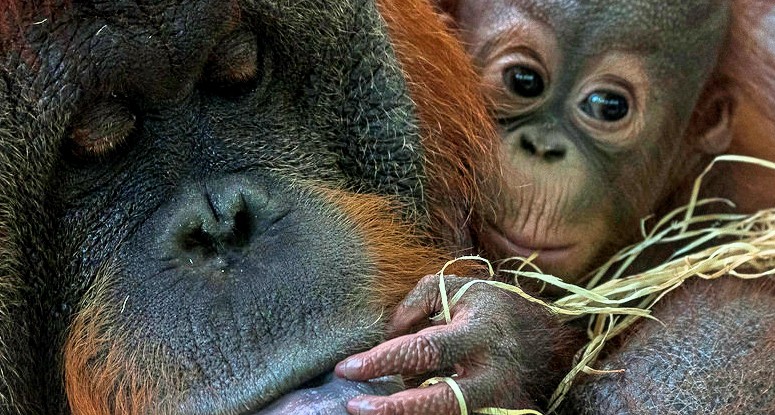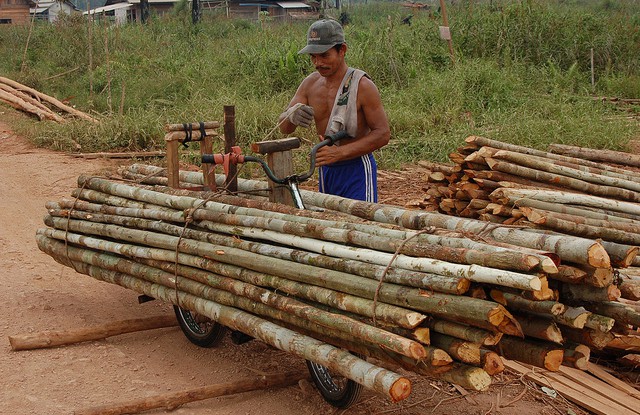BOGOR, Indonesia: Orangutan populations in the Indonesian islands of Sumatra and Borneo have suffered decades of population decline due to habitat loss.
In Borneo alone, the International Union for the Conservation of Nature (IUCN) estimates that more than 50 percent of the population has been lost in the last 60 years.
This loss has drawn attention to the role played by logging and the oil palm industry in the rapid loss of lowland forests—which are the orangutan’s primary habitat.
With nearly half of Indonesian Borneo’s remaining forest earmarked for development, conservation groups and environmental activists have called for strong protection of lowland forests to protect the species from Kalimantan’s palm oil and population booms.
However, a new study suggests that with climate change, these noble convictions may be misplaced.
Rather than focusing on the effects of climate change alone, the researchers used ten years of satellite data, and models incorporating both land-cover and climate-change scenarios to predict the availability of suitable orangutan habitat until 2080.
Future rates of deforestation and land-use changes could cost the orangutan 15-30 percent of its current habitat.
However, under climate change models, which project the impact of temperature and rainfall changes on the quality of habitat, 63 percent of the current Borneo range could be unable to sustain orangutan populations.
There's already empirical evidence across the World showing that species living in lowland areas, in warmer areas, tend to migrate upland with climate change
By combining these models to take into account both land use change and climate change, the study found that the great ape might well lose up to 74 percent of its currently suitable habitat in the next six decades.
Though much of the lowland forest may not remain optimum for orangutans, the study also identified potential refuge areas—up to 42,000 square kilometers—which may become suitable as their current habitat disappears.
INCREMENTAL MIGRATION
Orangutans have historically kept to lower elevations.
However, a growing body of research suggests that as lowlands heat up, tropical species may slowly seek refuge from these adverse conditions by shifting upslope, where temperatures are cooler—making conservation initiatives that focus on the lowlands only beneficial in the short term.
“There’s already empirical evidence across the World showing that species living in lowland areas, in warmer areas, tend to migrate upland with climate change. This phenomenon has already begun to happen,” says David Gaveau, a scientist at Center for International Forestry Research (CIFOR) and co-author of the study.
CONSERVE TO CONNECT
This change in the orangutan conservation narrative need not necessarily be a cause for worry. According to the study, many of the upland areas predicted to become suitable habitat for orangutans are already under some measure of protection.
“Because those protected areas are already established, we found that we need to only increase a small increment of protected land in the lowlands,” says lead author Matthew Struebig, from the Durrell Institute of Conservation and Ecology, at the University of Kent.
By expanding protections in some key areas of the existing lowland forests, the authors suggest that wildlife corridors between the currently suitable lowland forests and the upland protected areas would be created. This would allow orangutans and other mammals to move freely to new habitat over time, as some areas become more suitable.
If logging is done in a responsible way, by developing regulations that don’t allow people to play with loopholes in the system, forests can remain forever
At least one corridor has already shown promising results in Malaysian Borneo, which covers approximately 90 hectares of forest.
Connectivity, however, only matters if the habitat the animals reach remains hospitable. To ensure this, the authors suggest taking measures to be sure that suitable upland habitat is well managed in the interim, and does not succumb to population and development pressures that would result in clearing the forest.
NOT-SO-STRANGE BEDFELLOWS
Conserving the upland areas and profiting from them is not necessarily a zero-sum game, according to the study.
“There are already a lot of intact protected areas in Borneo’s uplands, because these are the least costly to set up and the most costly to develop. As a result, they’ve not been high on the conservation agenda until now,” says Struebig. “They might become much more important in light of climate change. However, the majority of these upland areas are classified as production forests, for extracting timber, as logging concessions.”
Keeping production forests is vital according to Gaveau. “You extract a few big trees, but you leave the rest,” Gaveau says. “Your seed bank is there, and your wildlife remains there. If you do it in a sustainable way you can make the forest pay for itself.”
It is an opportunity that Gaveau has researched for some time. Past studies have also shown that Bornean orangutans can cope well in responsibly logged landscapes.
If managed well, “It’s possible that the potential ally for the future of conservation in Borneo is the very industry that has been partially responsible for the demise of rainforests,” says Gaveau. “Some people might say that by partnering with logging companies we’d be working with the enemy. But realistically, it’s better to work with businesses with a vested interest in keeping forest cover than other industries that make a living by clearing forests completely.”
Making any economic partnership work with conservation initiatives could be a challenge. Currently, there are a variety of governance issues—insecure land titles, loopholes which allow land to be downgraded and lose protected status, and conflicts between national and local government’s land use plans—which can allow protected lands to be converted to oil palm plantations.
Gaveau remains hopeful.
“Logging is different,” says Gaveau. “If it is done in a responsible way, by developing regulations that don’t allow people to play with loopholes in the system, forests can remain forever.”
For more information about Indonesia’s orangutans, please contact David Gaveau at d.gaveau@cgiar.org
CIFOR’s work with the orangutan of Borneo is part of the CGIAR Research Program on Forests, Trees and Agroforestry .
We want you to share Forests News content, which is licensed under Creative Commons Attribution-NonCommercial-ShareAlike 4.0 International (CC BY-NC-SA 4.0). This means you are free to redistribute our material for non-commercial purposes. All we ask is that you give Forests News appropriate credit and link to the original Forests News content, indicate if changes were made, and distribute your contributions under the same Creative Commons license. You must notify Forests News if you repost, reprint or reuse our materials by contacting forestsnews@cifor-icraf.org.


